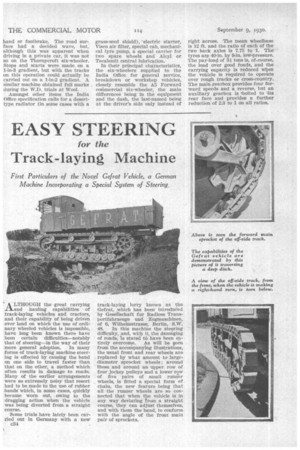SIX-WHEELER'S S ZCESS OVERSEAS
Page 54

Page 55

Page 56

If you've noticed an error in this article please click here to report it so we can fix it.
No Other Type of Vehicle is Doing So Much for Transport Under Difficult Operating Conditions. Roads, Deserts and Marshes Conquered The Rigid Six-wheeler is Almost as Good on Crosscountry Work as the Track Machine, Whilst its Performance on Even Moder ate Roads is Better
IT may well be said that the rapid progress which is being made by the rigid-frame six-wheeler in meeting the most difficult operating conditions in many countries overseas constitutes one of the romances of the world of transport.
For a time it appeared as if the track-type machine was the only one which would be successful where the conditions rendered haulage particularly arduous, but the sixwheeler has developed so rapidly— in which development The Commercial Motor has played no small part —that it is beating the track machine in the latter's own particu
Jar sphere of cross-country transport, and has presented the additional and vitally important advantage that it can fully equal, and often better, the performance of the normal four-wheeled machine on ordinary roads.
The Government of India is fully alive to the potentialities of this comparatively new means and has given
practical proof oft this by its numerous large orders to those British builders who specialize in the manufacture of chassis which will meet its somewhat stringent requirements. John I. Thornycroft and Co., Ltd., Thornycroft House, Smith Square, Westminster, London, S.W.1, for in stance, has, during the past 12 months, supplied 157 rigid , sixwheelers to the India Office, in addition to 104 to our own War Department.
These machines must not only
have special equipment, which varies with different orders, but must undergo the most strenuous and searching tests against which no four-wheeled vViicle would be proof. Several of our illustrations will give an idea of some of the trials, perhaps the worst of which is the traversing of staggered concrete blocks of considerable height, which so rack the chassis that the onlookers can only be amazed that DO damage occurs to the frame and other parts of the vehicle,
• The patented system of bogie suspension utilized on six-wheeled vehicles of this make has much to do with their success, but every other part of the chassis must be of corresponding strength and good design.
As to the performance on ordinary roads, we had a short run on the A5 Forward six-wheeler as supplied to the India Office. This carried a load of 4 tons 8 cwt., although built for a load of 3i tons, including the body.
The six-cylindered engine has a 31-in. bore and 5i-in. stroke, giving an R.A.C. rating of 33.8 h.p. On third gear 33 m.p.h. was obtained, and with the governor screwed down we reached 42 m.p.h. on top, although actually this could have been exceeded but for the fact that we were somewhat precariously perched. The absence of rolling when running around a corner at over 30 m.p.h. was surprising, whilst the braking power proved to be such that the four wheels of the bogie could be locked by the application of either hand or footbrake. The road surface had a decided wave, but, although this was apparent when driving in a private car, it was not so on the Thornycroft six-wheeler. Stops and starts were made on a 1-in-3 gradient, but with the tracks on this operation could actually be carried out on a 1-in-2 gradient. A similar machine obtained full marks during the W.D. trials at Wool.
Amongst other items the India Office specification calls for a desert type radiator (in some cases with a
grass-seed shield), -electric starter, Visco air filter, special cab, mechanical tyre pump, a special carrier for two spare wheels and Alcyl or Tecalemit central lubrication.
In their principal characteristics, the six-wheelers supplied to the India Office for general service, breakdown or workshop vehicles, closely resemble the A5 Forward commercial six-wheeler, the main differences being in the equipment and the dash, the last-named being at the driver's side only instead of right across. The mean wheelbase is 12 ft. and the ratio of each of the two back axles is 7.75 to 1. The tyres are 40-in. by 9:1n. low-pressure. The pay-load of Si tons is, of.course, the load over good oads, and the carrying capacity is reduced when the vehicle is required to operate over rough tracks or cross-country. The main.gearbox provides four forward speeds and a reverse, but an auxiliary gearbox is ?bolted to =Its rear face and provides a further reduction of 2.3 to 1 on all ratios.












































































































